(page 20)
November 16, 2004
Review: The Bench Press by Biasiotto and Arndt
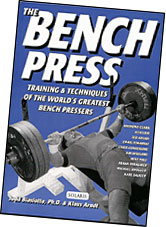 The first powerlifting book to graze my vast shelves was Power (1998) by legendary Judd Biasiotto. Described as a book written by a “guy weighing 131 pounds [59.5 kg] with legs that look like a pair of pliers in shorts who can squat 575 pounds [261 kg]”, Power was packed with twenty-eight short chapters on everything from psyching up to lifting technique. Suffice it to say, this little gem dynamited with valuable information made me more than a little favorably disposed toward Biasiotto’s and Arndt’s The Bench Press. I had been aware of this book for some time, but my recent foray into the finer points of benching technique made me finally decide to invest some of my hard-earned cash on it ($14.95 USD for the book and $12.00 airmail from DrJudd.net). Subtitled Training & Techniques of the World’s Greatest Bench Pressers, this sounded like just the ticket to learning more intricacies from lifters who benched during the era when heels were firmly planted on the floor (the style I currently use).
The first powerlifting book to graze my vast shelves was Power (1998) by legendary Judd Biasiotto. Described as a book written by a “guy weighing 131 pounds [59.5 kg] with legs that look like a pair of pliers in shorts who can squat 575 pounds [261 kg]”, Power was packed with twenty-eight short chapters on everything from psyching up to lifting technique. Suffice it to say, this little gem dynamited with valuable information made me more than a little favorably disposed toward Biasiotto’s and Arndt’s The Bench Press. I had been aware of this book for some time, but my recent foray into the finer points of benching technique made me finally decide to invest some of my hard-earned cash on it ($14.95 USD for the book and $12.00 airmail from DrJudd.net). Subtitled Training & Techniques of the World’s Greatest Bench Pressers, this sounded like just the ticket to learning more intricacies from lifters who benched during the era when heels were firmly planted on the floor (the style I currently use).
The 126 page book consists of chapters around 10 pages long on a selection of immortal benchers from both the States and Europe who saw their heyday between the 1960s and mid 1990s: Anthony Clark, Ken Lain, Ted Arcidi, Craig Tokarski, Chris Confessore, Jim Williams, Mike Hall, Frank Pfaumer, Michael Brügger and Karl Saliger. Loaded with great photos contributed by Powerlifting USA, the chapters tell the story of how these men began their benching career and how they progressed towards the huge lifts they left their mark with. It is intriguing in its own right to read how Arcidi lived in a cellar after being disowned by his father for pursuing a lifting career or how Williams got into lifting by giving a local YMCA barbell a spin in between dancing every Saturday… not to mention how Clark decided to use a reverse grip in order to “break the world record backwards” as proof of God’s strength. The last part of every chapter discusses the lifter’s training on the level of what exercises they believe are most beneficial and what routine they have found to work best for them. Lastly, every chapter also contains a power tip from every lifter that can be anything from “bench with as wide a grip as possible” to “do plate raises for the delts”.
On the whole, the books was a lot more general than I had hoped for. The life stories contribute little towards an understanding of how these lifters honed their technique and training routines over the years. The discussion on training methodology rarely goes beyond “arch your back” and “have long-term goals” and exercises are usually mentioned without much explanation of finer points or why they are important. The Bench Press comes across splendidly as a candid account where the lifter’s tell their own story in their own words, but it would be a mistake to think that this is a good manual on how to learn the dark arts of benching. In my opinion, it should really be subtitled something like Biographies of the World’s Greatest Bench Pressers. As such, it is a great book that should really be owned by anyone interested in powerlifting history or anyone who wants a quick inspirational read with some great photos.
That being said, there is one major exception and that is the section on Ken Lain. He is introduced as a technician who cared for the nitty-gritties of flawless technique. The first thing that struck me [hard] was a discussion on rowing the shoulders back on descent.
One thing Lain does differently is the “shoulder row”, as he calls it. “If you stick your arms straight out in front of you, and shrug your shoulders to your ears, your arms will drop six inches, without even bending at the elbow. So when you are coming down with the bar, you actually row your shoulders towards your ears. This will decrease the distance that you’ll have to drop the bar. Plus you are giving yourself a lot of strength and power off the bottom, by bringing the lats into play.
Biasiotto, Judd and Arndt, Klaus: The Bench Press, Solaris 2001 [2nd ed.]; pp. 39.
Don’t know if anyone besides Lain is known to do this, but this is sure interesting stuff. After talking about the essentials of arching, he goes on to talk about how he grips the bar.
“Most people will grab the bar with their hands, just staying straight on it, and then let the wrists rotate backwards. Take a pencil and let it rest on your thumb and the bottom of the heel of your hand. Look, that is the way my grip is. The tip of my little finger rides right on top of the bar, because I twist my hands slightly forward. By doing this, I’m putting the bar in a direct line to the center of my wrist. […] [This way] you get your delts in a better position to work for you.
Biasiotto, Judd and Arndt, Klaus: The Bench Press, Solaris 2001 [2nd ed.]; pp. 40.
This makes me think Lain’s book Add 50 to 75 lbs. to Your Bench Press might be a worthwhile read, but that is a different story…
New journal and IPA forum
Been busy sleeping for the last few days (really!) and am somewhat behind on both e-mail and announcements. Got an e-mail from Mike who told me he started a new journal with Diaryland.com with the intention of documenting his way towards a 550 lbs/250 kg bench by the end of 2005. Mike is also going to a meet on December 11, so his journal should provide an interesting read.
If anyone competing in the IPA reads this, you might also be interested in the new IPA Power message board.
November 15, 2004
Upping the ante on the decline
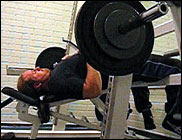 The change in bench technique still feels awkward, but progress towards my short-term goal of 4x6 @ 90 kg/199 lbs continued with 5,5,3,3 @ 85 kg/188 lbs - a big improvement over last week’s mediocre session. Increased the weight on the decline to 85 kg/188 lbs, but narrowly failed to reach the 3x5 goal (VIDEO 2.9M). Don’t know if it was the flat or decline, but the workout left me with some strain on the inside of my left arm. Probably nothing the sauna, some light massage and rest won’t fix, but it remains to be seen if my body can cope with the twice-weekly heavy full-range pressing. Speaking of saunas, the good thing about living in Finland is that saunas are routinely part of a normal apartment like ours - there are approximately 1.8 million saunas to the 5.2 inhabitants (one sauna per every three persons!). I heat up ours about five times a week now and hardly a day goes by when I don’t reflect on how lucky I am to have one at finger’s reach. Nothing like a 90 ‘C/194 ‘F sauna after a strenuous workout. If progress stops I can always blame it on the vitamin B supplement I “occasionally” ingest after the sauna.
The change in bench technique still feels awkward, but progress towards my short-term goal of 4x6 @ 90 kg/199 lbs continued with 5,5,3,3 @ 85 kg/188 lbs - a big improvement over last week’s mediocre session. Increased the weight on the decline to 85 kg/188 lbs, but narrowly failed to reach the 3x5 goal (VIDEO 2.9M). Don’t know if it was the flat or decline, but the workout left me with some strain on the inside of my left arm. Probably nothing the sauna, some light massage and rest won’t fix, but it remains to be seen if my body can cope with the twice-weekly heavy full-range pressing. Speaking of saunas, the good thing about living in Finland is that saunas are routinely part of a normal apartment like ours - there are approximately 1.8 million saunas to the 5.2 inhabitants (one sauna per every three persons!). I heat up ours about five times a week now and hardly a day goes by when I don’t reflect on how lucky I am to have one at finger’s reach. Nothing like a 90 ‘C/194 ‘F sauna after a strenuous workout. If progress stops I can always blame it on the vitamin B supplement I “occasionally” ingest after the sauna.
Bench: 5,5,3,3 @ 85 kg/188 lbs
Decline bench: 5,4,4 @ 85 kg/188 lbs
Pulldown to upper chest, wide-grip: 4x10 @ 90 kg/199 lbs
Rope pull: 3x8 @ 50 kg/111 lbs
Seated hammer curl: 6,5,4 @ 21 kg/46 lbs
Total training time: 79 min
November 12, 2004
Math challenged
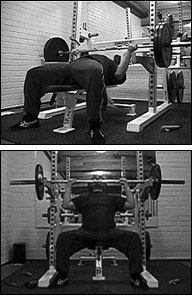 Time to get serious about the modified Blakley assist day. Sleep has not been plentiful this week, and thus took a nap followed by a bottle of Nitric Force in an attempt to redeem the three hours of nocturnal rest I had yesterday. Alert enough.
Time to get serious about the modified Blakley assist day. Sleep has not been plentiful this week, and thus took a nap followed by a bottle of Nitric Force in an attempt to redeem the three hours of nocturnal rest I had yesterday. Alert enough.
Used this workout to get a feeler for what suitable starting weights would be as I didn’t have the foggiest on how much I could move on the reverse grip bench or seated press. The reverse bench felt surprisingly natural, but I could definitively feel a degree of wrist strain using my normal bench grip width. After two easy 80 kg/177 lbs lifts, my sleep deprived brain, surging with artificial caffeine energy, convinced me I had just done an easy rep with 90 kg/199 lbs. With unfailing logic, I thus loaded two plates on the bar. Before I knew it, the bar and I were locked in a cold embrace, unable to part. Then following three repper with 82.5 kg/182 lbs (lost my groove, but six reps is doubtful) makes me think good starting weights for the reverse bench is 90 kg/199 lbs for the single and 77.5 kg/171 lbs for the 4x6.
Decided to do the seated press in traditional Westside style, i.e. off pins set at chin height with back support. This makes for less eccentric strain on the muscles since the bar can be semi-dropped down, while allowing for maximum explosivity by relaxing in between reps. After a decent six rep set with 60 kg/133 lbs, I wanted to see how many reps I’d get with 70 kg/155 lbs. The answer was two; a bit better than I’d thought off hand. Next week I will begin the sets with 62.5 kg/138 lbs. Wrapped up with some lat and cuff work, then home to sleep. My main goal next week is definitively to sleep more and give Sanna more time. The workload has been pretty severe for the last couple of weeks, but should ease up a little now.
Reverse-grip bench:
10 @ 20 kg/44 lbs
6 @ 40 kg/88 lbs
5 @ 50 kg/111 lbs
3 @ 60 kg/133 lbs
2 @ 70 kg/155 lbs
2x1 @ 80 kg/177 lbs
0 @ 100 kg/221 lbs
3 @ 82.5 kg/182 lbs (lost groove)
Seated pin press, medium grip:
6 @ 40 kg/88 lbs
6 @ 50 kg/111 lbs
6 @ 60 kg/133 lbs
2 @ 70 kg/155 lbs
One-handed cable row: 4x6 @ 70 kg/155 lbs
Lying L-flye: 3x8 @ 8 kg/18 lbs
Total training time: about an hour
November 10, 2004
Good honest work
The sudden relapse into lumbago after several months of hard rehab work made me lose a lot of the enthusiasm I had. After a hiatus of two months, I now seem to have regained faith. It was a joy to blast the back with hyperextensions off a swiss ball with a barbell on the back (clip to come at some point), and even worked up to 10 @ 70 kg/155 lbs on the, gulp, deadlift! As I’ve noted before, the key appears to do slow reps. Will slowly try to build up the weights from here and see what happens. So far everything is dandy. Wrapped up with some heavy ab work and also fell in love with the incline sit-up board. Just what my hip flexors need.
Barbell hyperextension on swiss ball:
2x10 @ 20 kg/44 lbs
2x10 @ 30 kg/66 lbs
Deadlift (slow):
10 @ 40 kg/88 lbs
10 @ 50 kg/111 lbs
10 @ 60 kg/133 lbs
10 @ 70 kg/155 lbs
Upper body cable turn: 3x20 @ 50 kg/111 lbs
Barbell side bend: 3x10 @ 40 kg/88 lbs
Incline board sit-up (full reps): 7,6,4
Standing cable crunch: 10 @ 35 kg/77 lbs
Arm and leg extension kneeling on stability ball: 4 (ball very shaky, fell off)
Total training time: 73 min
WPC and WPO Bench Bash videos
Ano approved of my WPC/WPO Bench Bash meet report and cleared the clips I took. Thanks Ano!! For official results and more meet footage see the meet page at gometal.com.
WPC
Murtomäki’s phenomenal 300 kg/661.2 lbs opener - young guns indeed.
WPO
Lightweights
Middleweights
Ponomarenko redefines triple bodyweight with 310 kg/683.2 lbs and 320 kg/705.2 lbs lifts. I predict this guy will take the Arnold’s middleweight division.
Vinni gets a slow start with 290 kg/639.2 lbs, but up it goes.
Heavyweights
Hämäläinen’s controversial 330 kg/727.5 lbs followed by a convincing 340 kg/749.5 lbs lift.
Rantanen didn’t get further than this 330 kg/727.5 lbs opener - but it was enough to propel him into the Arnold’s.
Women’s guest class
Hayduchenko proves women can do it too with an amazing 190 kg/418.7 lbs lift.
November 8, 2004
Declined
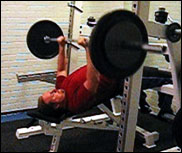 Four hours of sleep on top of five the night before - not precisely the prerequisites for an astounding bench session. The warm-up weights felt jarring and the actual work sets were no better. Bailed out after two mediocre first sets on the bench. As dictated by the new routine, I next did 3x5 of declines. Laying head down on an incline bench with feet wrapped around the end beams on the rack proved to be a great setup. Will pile on a bit more iron on these next week when I will hopefully be a bit less zombie-like.
Four hours of sleep on top of five the night before - not precisely the prerequisites for an astounding bench session. The warm-up weights felt jarring and the actual work sets were no better. Bailed out after two mediocre first sets on the bench. As dictated by the new routine, I next did 3x5 of declines. Laying head down on an incline bench with feet wrapped around the end beams on the rack proved to be a great setup. Will pile on a bit more iron on these next week when I will hopefully be a bit less zombie-like.
Bench: 4,3 @ 85 kg/188 lbs
Decline bench: 3x5 @ 80 kg/177 lbs
Pulldown to upper chest, wide-grip: 3x6 @ 90 kg/199 lbs
Pulldown to forehead: 3x10 @ 80 kg/177 lbs
Plate curl:
2 @ 10 kg/22 lbs
7,4 @ pinch gripping 5 kg/11 lbs, 2.5 kg/6 lbs and 1.25 kg/3 lbs plates
Reverse cable curl: 10,8 @ 50 kg/111 lbs
Total training time: What is time anyway?
November 7, 2004
Meet report: WPC and WPO Bench Bash, Helsinki
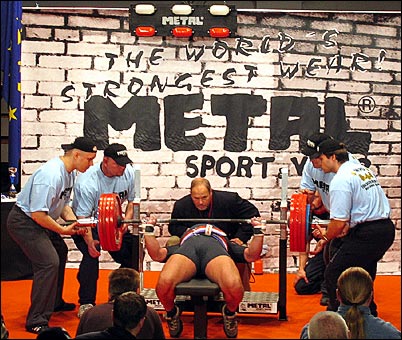
Finnish lifter Eero Jälkö with 250 kg/551 lbs under the attentive gaze of head referee Mike Sweeney (WPC Bench Bash 7 November 2004, Helsinki, Finland).
This blog is not particularly well-known for its thorough meet coverage; in fact, it is rare to see any mention whatsoever of the latest results in the powerlifting world. But when the World Powerlifting Organization (WPO) arranges their inaugural bench meet outside of the States in my home town… well, then I’m all there and excited like the rest of Strength Finland. I must say the occasion left me with newfound respect for competitive benching, shirts and all.
There was a lot at stake in this WPO Bench Bash for Cash since the event was the last qualifier for the WPO World Record Bench Bash at the 2005 Arnold Fitness Weekend in Columbus, Ohio. This meant an open door to Arnold’s for any lifter who could outbench someone on the US dominated qualifying list. As it turned out, the Americans chose to sit tight back home and await the outcome. In retrospect, a few of them shouldn’t have.
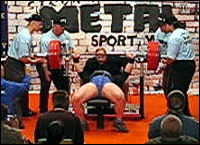 The minimum requirement to even lay down on the WPO bench was a result of 205 kg/451 lbs in the lightweights, 250 kg/551 lbs in the middleweights and a whopping 317.5 kg/699 lbs in the heavyweights. The meet was left open to new competitors until the very last minute and total radio silence was kept on who was going to show up until the meet actually began. The meet was also preceded by a World Powerlifting Congress (WPC) Bench Bash where anyone who managed to break the minimum requirements were entitled to stay around for the real deal in the afternoon. Finnish lifter Jani Murtomäki, only 23 years old, had unofficially announced his intention to do just that in the heavyweights and his tremendously explosive opener at 300 kg/661.2 lbs left the audience with little doubt over his seriousness. In the end, 317.5 kg/699 lbs turned out to be too much for his first meet ever. By afternoon all WPC lifters had abandoned their bench shirts for the audience.
The minimum requirement to even lay down on the WPO bench was a result of 205 kg/451 lbs in the lightweights, 250 kg/551 lbs in the middleweights and a whopping 317.5 kg/699 lbs in the heavyweights. The meet was left open to new competitors until the very last minute and total radio silence was kept on who was going to show up until the meet actually began. The meet was also preceded by a World Powerlifting Congress (WPC) Bench Bash where anyone who managed to break the minimum requirements were entitled to stay around for the real deal in the afternoon. Finnish lifter Jani Murtomäki, only 23 years old, had unofficially announced his intention to do just that in the heavyweights and his tremendously explosive opener at 300 kg/661.2 lbs left the audience with little doubt over his seriousness. In the end, 317.5 kg/699 lbs turned out to be too much for his first meet ever. By afternoon all WPC lifters had abandoned their bench shirts for the audience.
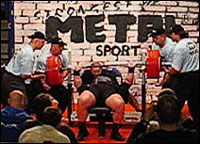 Whereas the WPC meet was a predominantly Finnish affair lifted in three groups, the WPO meet had a more level field of Ukrainians, Finns, Swedes and Russians lifting in a single group. Those among us who are not so knowledgeable about federations and powerlifting politics could only silently wonder whether there are no great benchers in the rest of Europe. This thought did not stay around to haunt as the speaker, whose English was perhaps not quite the best at all times, announced that several lifters had opening attempts that, if successful, would qualify them for the Arnold’s immediately. After the opening round was dispensed with the middleweights saw Ukrainian middleweight Vitaly Ponomarenko (310 kg/683.2 lbs) push Jim Kilts (280 kg/617.2 lbs) off the qualifying list, while Finnish heavyweights Mikko Hämäläinen (330 kg/727.5 lbs) and Tomi Rantanen (330 kg/727.5) sent cold greetings to Bart Quinn (305 kg/672.2 lbs) and Joe Ladnier (325 kg/716.2 lbs). Next round, Russian lightweight Andrey Tschesnokov (225 kg) joined the club, then it was middleweight Finnish lifter Esa Vinni’s turn with a new Finnish (and European?) record of 290 kg/639.2 lbs. The only lifter not having a ball was Vladimir Kravtsov of Russia with no passed lift due to what seemed to be a problem at achieving lockout with the right arm. If he had made his 332.5 kg/733 lbs lift he would have been in too. What a show!
Whereas the WPC meet was a predominantly Finnish affair lifted in three groups, the WPO meet had a more level field of Ukrainians, Finns, Swedes and Russians lifting in a single group. Those among us who are not so knowledgeable about federations and powerlifting politics could only silently wonder whether there are no great benchers in the rest of Europe. This thought did not stay around to haunt as the speaker, whose English was perhaps not quite the best at all times, announced that several lifters had opening attempts that, if successful, would qualify them for the Arnold’s immediately. After the opening round was dispensed with the middleweights saw Ukrainian middleweight Vitaly Ponomarenko (310 kg/683.2 lbs) push Jim Kilts (280 kg/617.2 lbs) off the qualifying list, while Finnish heavyweights Mikko Hämäläinen (330 kg/727.5 lbs) and Tomi Rantanen (330 kg/727.5) sent cold greetings to Bart Quinn (305 kg/672.2 lbs) and Joe Ladnier (325 kg/716.2 lbs). Next round, Russian lightweight Andrey Tschesnokov (225 kg) joined the club, then it was middleweight Finnish lifter Esa Vinni’s turn with a new Finnish (and European?) record of 290 kg/639.2 lbs. The only lifter not having a ball was Vladimir Kravtsov of Russia with no passed lift due to what seemed to be a problem at achieving lockout with the right arm. If he had made his 332.5 kg/733 lbs lift he would have been in too. What a show!
The WPO event also had three female guest lifters who posted some impressive numbers. Anna Rosén, Swedish WPC lifter Göran Rosén’s better half, worked up to 155 kg/341.5 lbs with a smile on her face, while seasoned Finnish lifter Tarja Rantanen fell just short of the Finnish Record with a 160 kg/352.5 lbs lift. Strongest among them was Lyudmila Hayduchenko with a 190 kg/418.7 lbs third lift.
All in all this was a well-organized meet, something Mike Sweeney was quick to point out on several occasions. The meet ran without a glitch, on schedule and with a judging policy that appeared fairly strict to the untrained eye. Faith for arranger Ano Turtiainen is indeed high as Helsinki has already been promised the WPC World’s and WPO European Championships for 2005. Turtiainen’s now legendary Metal gear, the official sponsor of this event, was not only well-represented on stage, but they also had a big booth selling everything from training pants to bench shirts. Besides some supplements and a little something at a small booth manned by Sakari Selkäinaho from Voimaharjoittelu.net, there wasn’t too much else on sale. In the end, that was not why most of us were there anyhow, but a few videos would probably not have hurt sales.
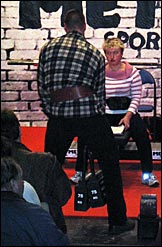 The warm-up area was just behind the main lifting platform and it was fun to follow the lifters warm up in the background, which provided good opportunity for further reflection on bench set-up and foot positioning… A grip contest arranged by Rautakoura.com (”iron grip dot com”) was also held in the breaks between groups (gallery from the event). Two 75 kg suitcases were to be gripped with one hand. Anna Rosen managed to break the current Women’s world record (1 second) in this novel grip competition with a 7 second hold. The main prize in the men’s competition was taken by a construction worker with no lifting experience.
The warm-up area was just behind the main lifting platform and it was fun to follow the lifters warm up in the background, which provided good opportunity for further reflection on bench set-up and foot positioning… A grip contest arranged by Rautakoura.com (”iron grip dot com”) was also held in the breaks between groups (gallery from the event). Two 75 kg suitcases were to be gripped with one hand. Anna Rosen managed to break the current Women’s world record (1 second) in this novel grip competition with a 7 second hold. The main prize in the men’s competition was taken by a construction worker with no lifting experience.
Below are the WPO results as gleaned from the scoreboard. These are not official, but I have no reason to doubt that they will change. I also have clips of many key lifts, but I am going to clear them with Ano before I add them to this entry. In all fairness it did say “no videotaping of this event”, so nobody really expects him to say yes.
WPO BENCH BASH FOR CASH, HELSINKI 7 NOV 2004 RESULTS (UNOFFICIAL)
Women’s guest class
| NAME | WEIGHT | BP1 | BP2 | BP3 | TOTAL/POINTS | |
| 1. | Haydychenko, Lyudmila (UKR) | 89,60 | 180,0 | 0,0 | 190,0 | 190,0/270,18 |
| 2. | Rantanen, Tarja (FIN) | 89,10 | 160,0 | 0,0 | 0,0 | 160,0/228 |
| 3. | Rosén, Anna (SWE) | 90,00 | 140,0 | 150,0 | 155,0 | 155,0/220,1 |
Men’s lightweight class
| NAME | WEIGHT | BP1 | BP2 | BP3 | TOTAL/POINTS | |
| 1. | Tchesnokov, Andrey (RUS) | 74,90 | 210,0 | 225,0 | 0,0 | 225,0/251,325 |
Men’s middleweight class
| NAME | WEIGHT | BP1 | BP2 | BP3 | TOTAL/POINTS | |
| 1. | Ponomarenko, Vitaliy (UKR) | 99,70 | 310,0 | 320,0 | 0,0 | 320,0/293,12 |
| 2. | Vinni, Esa (FIN) | 99,10 | 270,0 | 277,5 | 290,0 | 290,0/266,22 |
Men’s heavyweight class
| NAME | WEIGHT | BP1 | BP2 | BP3 | TOTAL/POINTS | |
| 1. | Hämäläinen, Mikko (FIN) | 137,40 | 330,0 | 340,0 | 0,0 | 340,0/286,62 |
| 2. | Rantanen, Tomi (FIN) | 128,50 | 330,0 | 0,0 | 0,0 | 330,0/281,49 |
And finally, the results put into the Men’s qualifier list presented at the event (picture). Again these are unofficial. Last year’s top three (boldfaced) plus the five best benchers of the three qualifiers are eligible to receive an invitation to the Arnold’s. Newcomers from today’s meet are marked with an * and outgoers are striked out. Note that the lightweight class only had three lifters out of five in it, hence no dropouts in that class.
WPO WORLD RECORD BENCH BASH, 2005 ARNOLD FITNESS WEEKEND QUALIFIER LIST (UNOFFICIAL)
Lightweights
| Markus Shick | 273 |
| Joe Mazza | 247,5 |
| August Clark Jr. | 240 |
| Brad Heck | 232,5 |
| * Andrey Tchesnokov | 225,0 |
| Taylor Tom | 222,5 |
| Brian Schwab | 217,5 |
Middleweights
| Scott Albano | 320 |
| Jesse Kellum | 300 |
| Chip Stewart | 300 |
| * Ponomarenko, Vitaliy | 320 |
| Scott Rabine | 311 |
| Brad Hein | 307,5 |
| Rene Imesch | 300 |
| * Esa Vinni | 290 |
| 287,5 | |
| 280 |
Heavyweights
| Gene Rychlak | 397,5 |
| Shawn Lattimer | 390 |
| Ryan Kennelly | 372,5 |
| Clay Brandenburg | 370 |
| Chris Cooke | 365 |
| George Halbert | 347,5 |
| * Mikko Hämäläinen | 340 |
| * Tomi Rantanen | 330 |
| 325 | |
| 305 |
November 5, 2004
The chain is only as strong as…
It is always a pleasure to see some of you turn from yet another hit in the web logs into a reader with a name and, usually, a loaded barbell that you are not afraid to use. After some astute observations on my benching form, Mike had this to say about the subsequent video:
Just finished watching your video and wanted to send congrats about the PR. Your form from the side looks a lot like kennellys’. It seems your weak point is right where the transfer of shoulders to triceps takes over. I have a few exercises that will help this as it was once my weak point. Try Dips, Reverse Grip Bench, and seated front presses. Give these some serious work on your Blakely assistance day. Your lockout is very strong, which is quite evident on the 221 attempt.
In subsequent e-mails, he suggested close grip declines or flat benches as a second best replacement for dips (no dip stand at the school gym) and gave me this example routine:
Blakely Bench Day
Bench - 4x6
Dips or Decline or Close Grip - 3x5
I highly recommend Dips working up to your bench max in total weight(BWT+Added wt.) for 5 reps.
Rear Delts - 3x8
Blakely Assistance Day
Reverse Bench - 1x1 with about 90%, 3x6 Blakely style
Shoulder Press - 4x6
Rear Delts - 3x8
I’ve decided to give this routine a shot. Felt it wise to take some extra rest following Monday’s maxing out, so just looked over the set up for the new exercises before proceeding to lat and biceps work. Declines on Monday. But before that I will of course attend the WPC World Bench Bash and the WPO Bench Bash For Cash here in Helsinki on Sunday.
Wide-grip pulldown facing away from machine: 3x5 @ 70 kg/155 lbs
Close-grip pulldown to upper chest: 4x7 @ 80 kg/177 lbs
Modified row: 14 @ 80 kg/177 lbs
Low incline hammer curl:
4 @ 21 kg/46 lbs
3x8 @ 16 kg/35 lbs (continuous tension)
One-handed cable curl: 10 @ 20 kg/44 lbs
Total training time: 42 min
November 4, 2004
Sans Prophylactic Press
First it was sets of Sushi benches, then a week later Salmonella presses. After the initial confusion about Jim Wendler’s new exercises cleared the game was on.
Hey Jim, I was wondering what new terms for raw benching we have to look forward to over the coming months beside sushi and salmonella?
[..]
I’ve got a new one brewing for tomorrow. In fact, I’m going to do some raw benching just so I can use it.
…which he did of course. I’m too jelly brained right now to do what any self-respecting blogger would do (i.e. give his own punny contribution or turn the tables by renaming shirt benches). Regular readers will no doubt know that I consider one of Wendler’s contributions just perfect anyway.